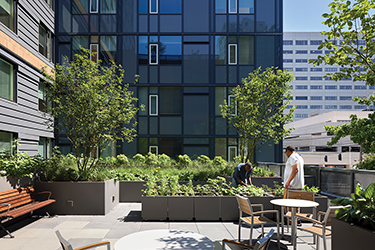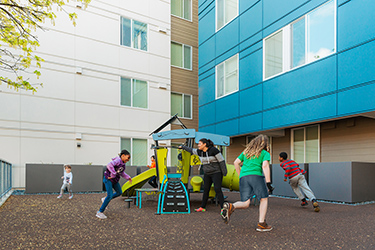|
Subscribe / Renew |
|
|
Contact Us |
|
| ► Subscribe to our Free Weekly Newsletter | |
| home | Welcome, sign in or click here to subscribe. | login |
Architecture & Engineering
| |
 |
February 29, 2024
Designing for health in affordable housing
Weber Thompson

Reibman
|
Housing is fundamental to our health as individuals and as a community. Centering human health and well-being in housing design can begin with crafting connections to nature, healthy indoor environments and spaces that foster community.
Nowhere is healthy design more important than in our stock of affordable housing. The growing awareness of housing as a health issue is reflected in shifting funding policies at all levels, from Federal Medicaid funds to state and local initiatives. Washington House bill 1866 now requires housing to be provided as a part of medical care for people experiencing chronic homelessness along with a major medical condition or disability. King County’s Health Through Housing Initiative is another notable example.
The imperative extends far beyond people exiting homelessness. Much of our affordable housing supply serves low-income families and individuals who simply cannot afford the high cost of stable housing in our region. Seniors on fixed incomes represent a growing share of those seeking affordable housing options, and many existing residents remain in affordable housing long-term, leading to an aging population of residents with growing health concerns.
Funders of affordable housing projects have taken notice, prioritizing projects in partnership with community health and services organizations. Many examples have recently opened their doors or are currently under construction.
• Orenda at Othello Square provides workforce housing above the new Odessa Brown Children’s Clinic in partnership with Seattle Children’s.
• Pride Place on Capitol Hill, a partnership between Community Roots Housing and GenPride, has opened the first LGBTQ+-affirming Affordable Senior Housing project that provides health and wellness services to elders.
• On North Beacon Hill, the Pacific Hospital PDA recognized housing as a part of their public health mission and sold a portion of their historic site to the Seattle Chinatown International District PDA. Their project, Beacon Pacific Village, is an intergenerational affordable housing project with an elder care center operated by A.I. Pace and an early learning facility by El Centro de la Raza.
Each project centers on health for residents and the community. Building on this awareness, we can and should prioritize healthy homes for everyone, especially for the most vulnerable among us.
THE HEALING POWER OF NATURE: BIOPHILIC DESIGN
Biophilic design harnesses the innate affinity humans have for being exposed to nature. Studies have consistently shown better outcomes for patients in healthcare settings with access to daylight and views of natural settings.
Similar studies have shown lower absenteeism in workplaces and improved test scores in schools when biophilic design elements such as high levels of natural light, indoor gardens, and views of nature are integrated into the space. Similar strategies can be used to incorporate biophilic design into affordable housing.
Larger windows bringing natural light into units, corridors and common areas, can provide views out to natural settings whenever possible. Well-designed outdoor spaces and community gardens provide direct access to nature and can encourage physical activity and community building. Bringing the outdoors in, with features like green wall systems, provides the benefits of nature regardless of the weather. We can also specify natural materials and finishes that enhance both units and community spaces. Updated codes now allow more exposed mass timber structure in larger buildings, another great opportunity to showcase the beauty of wood.
HEALTHY MATERIALS, HEALTHY AIR
Sick building syndrome and wildfire smoke are just two of the issues raising our awareness of indoor air quality. Whether working from home or adjusting to the northwest seasons, many of us are spending more time indoors. Tight building envelopes and mechanical ventilation systems required by our new energy codes make indoor air quality even more critical for human health and well-being. Adding higher levels of filtration to mechanical systems protects us from outdoor pollutants — but not the products inside our homes.
Fortunately, transparency in the supply chain is making it easier than ever to specify healthy materials in our buildings. Numerous green certifications, along with product databases such as Mindful Materials and Declare assist designers in finding better options. Certified red-list free products (products that do not contain known harmful chemicals) can be found for nearly every component of a modern structure, often with no added cost.
Materials and finishes that bring nature into our homes, such as natural wood and stone, as well as live plants can bring biophilic benefits along with improved indoor air quality.
COMMUNITY MATTERS
Designing to combat isolation and support the community is just as critical. Humans are social beings. Even the introverts among us (this author included) need interaction to thrive.
Isolation can lead to downward spirals of mental and physical health, especially for seniors living alone or others who are not working outside the home. We take better care of ourselves when we know other people care about us and depend on us for community activities.
The concept of the third place, popularized by social scientist Ray Oldenburg, promotes designing spaces for casual interaction outside of work and the immediate family. In these places, we develop community and friendships.
The social networks that support day-to-day health become even more important in an emergency or crisis. People are likely to check up on a friend if they don’t show up for a regular card game, book club, or other gathering. In times of trouble, we look out for those we know who may be vulnerable. Studies of excess deaths during heat waves show that people with close social ties are less likely to perish, while those without strong community connections are vulnerable.
These three simple approaches are powerful tools with proven results. Many decisions, such as the use of natural materials and high-quality gathering spaces, can have two or three benefits at once. If we value human health and well-being, we can’t afford to ignore these simple and effective design strategies.
Jeff Reibman is a senior principal and equity partner at Weber Thompson, leading the firm’s affordable housing and senior housing practice, as well as mixed use, mid-rise teams.
Other Stories:
- The need for high-performance building enclosure design
- Designing library spaces for the children of today
- Bypassing review to boost affordability
- Seattle’s commercial development at a crossroads
- Disrupting inequality in housing
- Trends transforming life-science building design
- Eight trends shaping design for cities in 2024
- Centering the patient and community in rural healthcare design
- Engineering with support from the sky
- Transforming yesterday’s spec office into the destination workplace of tomorrow
- An uncertain forecast for middle housing




